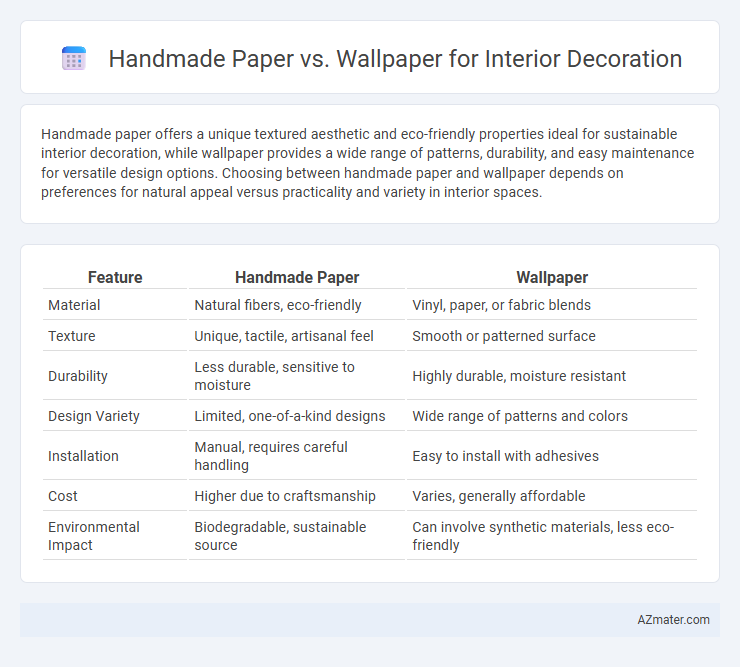Handmade paper offers a unique textured aesthetic and eco-friendly properties ideal for sustainable interior decoration, while wallpaper provides a wide range of patterns, durability, and easy maintenance for versatile design options. Choosing between handmade paper and wallpaper depends on preferences for natural appeal versus practicality and variety in interior spaces.
Table of Comparison
| Feature | Handmade Paper | Wallpaper |
|---|---|---|
| Material | Natural fibers, eco-friendly | Vinyl, paper, or fabric blends |
| Texture | Unique, tactile, artisanal feel | Smooth or patterned surface |
| Durability | Less durable, sensitive to moisture | Highly durable, moisture resistant |
| Design Variety | Limited, one-of-a-kind designs | Wide range of patterns and colors |
| Installation | Manual, requires careful handling | Easy to install with adhesives |
| Cost | Higher due to craftsmanship | Varies, generally affordable |
| Environmental Impact | Biodegradable, sustainable source | Can involve synthetic materials, less eco-friendly |
Introduction to Handmade Paper and Wallpaper
Handmade paper offers a unique, textured appearance crafted from natural fibers, making it an eco-friendly choice for interior decoration. Wallpaper provides versatility with various patterns, colors, and materials, enabling easy customization of spaces. Both materials serve distinct aesthetic purposes, with handmade paper emphasizing artisanal quality and wallpaper focusing on broad design options.
Aesthetic Appeal: Unique Textures and Designs
Handmade paper offers a distinctive aesthetic with its organic textures and natural fibers, creating a warm, artisanal feel that enhances interior decoration. Wallpaper provides a wide range of intricate patterns and vibrant colors, allowing for precise design customization to match various interior styles. The unique tactile qualities of handmade paper contrast with the smooth, often glossy surface of wallpaper, making each choice impactful for different decorative intentions.
Materials and Production Processes
Handmade paper is crafted from natural fibers such as cotton, hemp, or mulberry bark through a labor-intensive, artisanal process involving pulping, molding, and drying, resulting in unique textures and eco-friendly qualities. In contrast, wallpaper is typically produced using industrial methods on synthetic or coated paper materials, utilizing printing techniques like gravure or digital printing to create consistent patterns and finishes. The natural composition and manual production of handmade paper offer biodegradable and customizable options, while wallpaper manufacturing emphasizes durability and mass production efficiency.
Environmental Impact and Sustainability
Handmade paper offers a biodegradable, recyclable, and eco-friendly alternative to traditional wallpaper, often produced with natural fibers and minimal chemical processing. Wallpaper typically involves synthetic materials and adhesives, contributing to environmental pollution and waste disposal challenges. Choosing handmade paper enhances interior decoration sustainability by reducing carbon footprint and promoting resource-efficient craftsmanship.
Durability and Maintenance
Handmade paper offers unique textures and eco-friendly appeal but generally exhibits lower durability compared to wallpaper, which is designed to withstand wear and moisture. Wallpaper materials, such as vinyl and coated papers, offer superior resistance to scratches, stains, and humidity, making them easier to clean and maintain over time. Choosing wallpaper ensures long-lasting aesthetics and minimal upkeep, while handmade paper requires delicate handling and more frequent replacements in high-traffic areas.
Cost Comparison: Handmade Paper vs Wallpaper
Handmade paper generally incurs higher costs due to its artisanal production process and natural materials, making it a premium choice for unique, textured wall finishes. Wallpaper offers a wide range of price points, from budget-friendly mass-produced options to high-end designer prints, providing more flexibility for various budgets. While handmade paper adds value through durability and eco-friendliness, wallpaper remains the cost-effective option for large-scale interior decoration projects.
Customization and Personalization Options
Handmade paper offers unique customization through its textured patterns, natural fibers, and ability to embed personalized materials like flower petals or recycled textiles, creating one-of-a-kind wall art that reflects individual taste. Wallpaper provides extensive personalization via limitless printed designs, customizable colors, and patterns tailored to room dimensions, enabling cohesive themes or bold statements adaptable to contemporary or traditional interiors. Both materials support bespoke interior decoration, but handmade paper emphasizes craftsmanship and organic aesthetics, while wallpaper excels in versatility and precise design replication.
Installation Process and Ease
Handmade paper requires careful soaking and pasting, demanding precision and time during installation to avoid tearing or uneven surfaces, making it less convenient for DIY projects. Wallpaper often comes pre-pasted or ready to apply with adhesive, streamlining the installation process for faster and more uniform application. Choosing between handmade paper and wallpaper depends on balancing the artisanal texture and unique appeal of handmade paper against the practical ease and speed of wallpaper installation.
Suitable Spaces for Each Option
Handmade paper is ideal for cozy, artistic spaces such as bedrooms, living rooms, and boutique cafes, where its textured, natural fibers enhance warmth and authenticity. Wallpaper suits high-traffic areas like hallways, offices, and commercial spaces due to its durability, variety of patterns, and ease of maintenance. Choosing the right option depends on the room's function, desired ambiance, and exposure to wear and tear.
Trends and Expert Recommendations
Handmade paper brings a unique texture and eco-friendly appeal to interior decoration, favored by designers for its artisanal quality and sustainable attributes. Wallpaper remains popular for its vast array of patterns and ease of installation, with current trends leaning towards bold prints and customizable designs that complement modern aesthetics. Experts recommend combining handmade paper for accent walls with wallpaper on larger surfaces to create a balanced, visually stimulating environment that highlights craftsmanship and contemporary style.

Infographic: Handmade paper vs Wallpaper for Interior decoration
 azmater.com
azmater.com